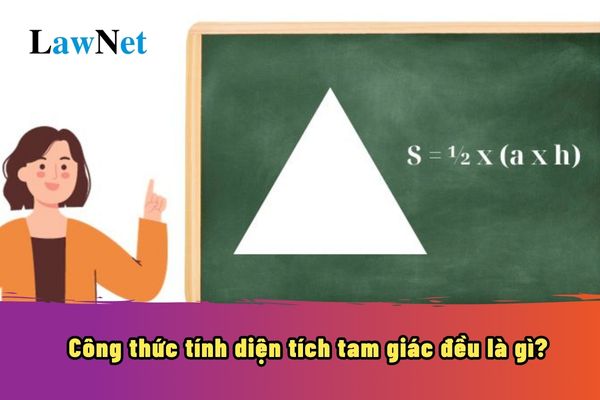Vietnam: What is the formula for calculating the area of an equilateral triangle? What is the grade at which the formula for calculating the area of an equilateral triangle is taught under the Mathematics curriculum?
What is the formula for calculating the area of an equilateral triangle?
Students may refer to the following formula for calculating the area of an equilateral triangle:
|
The formula for calculating the area of an equilateral triangle * When knowing the length of one side: |
*Note: Information is for reference only./.

What is the formula for calculating the area of an equilateral triangle? What is the grade at which the formula for calculating the area of an equilateral triangle is taught under the Mathematics curriculum? (Image from the Internet)
What is the formula for calculating the area of an equilateral triangle? What is the grade at which the formula for calculating the area of an equilateral triangle is taught under the Mathematics curriculum?
Under Section 5 of the Appendix to the General Education Program for Mathematics issued with Circular 32/2018/TT-BGDDT, the learning outcomes required for the 8th-grade Mathematics curriculum are as follows:
Required learning outcomes
Equilateral tetrahedron, regular quadrilateral pyramid
- Describe (apex, base, lateral face, lateral edge), establish an equilateral tetrahedron and regular quadrilateral pyramid.
- Calculate the surface area and volume of an equilateral tetrahedron and regular quadrilateral pyramid.
- Solve some practical problems associated with calculating the volume and surface area of an equilateral tetrahedron and regular quadrilateral pyramid (e.g., calculating the volume or surface area of some familiar objects in the form of an equilateral tetrahedron and regular quadrilateral pyramid, etc.).
Thus, under the above regulations, the formula for calculating the area of a triangle will be included in the 8th-grade Mathematics curriculum.
What is the educational method for 8th-grade Mathematics?
Under Section 6 of the General Education Program for Mathematics issued with Circular 32/2018/TT-BGDDT, the educational program for Mathematics in general and the 8th-grade Mathematics curriculum specifically will use the following methods:
- The teaching method in the Mathematics curriculum meets the following basic requirements:
+ Appropriate to the cognitive progression of students (moving from specific to abstract, from easy to difficult); not only focusing on the logic of mathematical science but also paying attention to approaches based on students’ experience and experience;
+ Emphasize the spirit of “student-centered learning,” promoting activeness, and self-discipline, considering the needs, cognitive abilities, and different learning methods of each student; organizing the teaching process towards construction, where students participate in discovery, reasoning, and problem-solving;
+ Flexible application of positive teaching methods and techniques; skillfully and creatively combining positive teaching methods and traditional teaching techniques; combining classroom teaching activities with practical experience activities, applying mathematical knowledge to real life. The lesson structure ensures a balanced, harmonious ratio between core knowledge, applied knowledge, and other components.
+ Use adequate and effective teaching aids, and learning tools per regulations for Mathematics; can use homemade teaching tools suitable for the lesson content and different student groups; enhance the use of information technology and modern teaching tools effectively and appropriately;
- Orientation of methods for developing core traits and general competencies
+ Methods for forming and developing core traits
Through organizing learning activities, Mathematics contributes, along with other subjects and educational activities, to helping students train honesty, love of labor, the spirit of responsibility, awareness of fulfilling learning tasks; nurturing confidence, interest in learning, the habit of reading, and the consciousness to explore and discover science.
+ Methods for forming and developing general competencies
++ Mathematics contributes to the formation and development of autonomy and self-learning by training learners to know how to choose goals, plan their learning, form self-learning methods, draw experience, and adjust to apply in other situations in learning concepts, knowledge, and mathematical skills as well as when practicing, exercising, or solving math problems, addressing mathematically significant issues.
++ Mathematics contributes to the formation and development of communication and collaboration competencies through understanding, reading comprehension, note-taking, and expressing necessary mathematical information in mathematical texts; through effectively using mathematical language combined with common language to exchange, present mathematical content, ideas, solutions in interaction with others, showing confidence and respect towards the interlocutor when describing, explaining mathematical content and ideas.
++ Mathematics contributes to the formation and development of problem-solving and creative competencies by helping students recognize problematic situations; share understanding of problems with others; propose, select methods, and processes to solve problems, and present solutions; evaluate solved solutions, and generalize for similar problems.
- Teaching methods in Mathematics contribute to the formation and development of computational skills, language skills, and other specific competencies. To be specific:
+ Mathematics, with its outstanding advantage, offers many opportunities to develop computational skills, showing in the provision of mathematical knowledge, practicing calculation skills, estimation, and forming and developing components of mathematical competencies (thinking and reasoning capacity, modeling ability, problem-solving capacity; communication ability and use of tools and means for learning mathematics).
+ Mathematics contributes to developing language skills through practicing reading comprehension, interpretation, analysis, and assessment of situations with mathematical significance, through the effective use of mathematical language combined with common language to present and express mathematical content, ideas, and solutions.
+ Mathematics contributes to the development of IT skills through using information technology and communication tools as learning aids and creating experiential learning environments.
+ Mathematics contributes to the development of aesthetic capacity by helping students become familiar with mathematical history, and biographies of mathematicians, and recognizing the beauty of Mathematics in the natural world.
>>> Download the General Education Program for Mathematics issued with Circular 32/2018/TT-BGDĐT.

